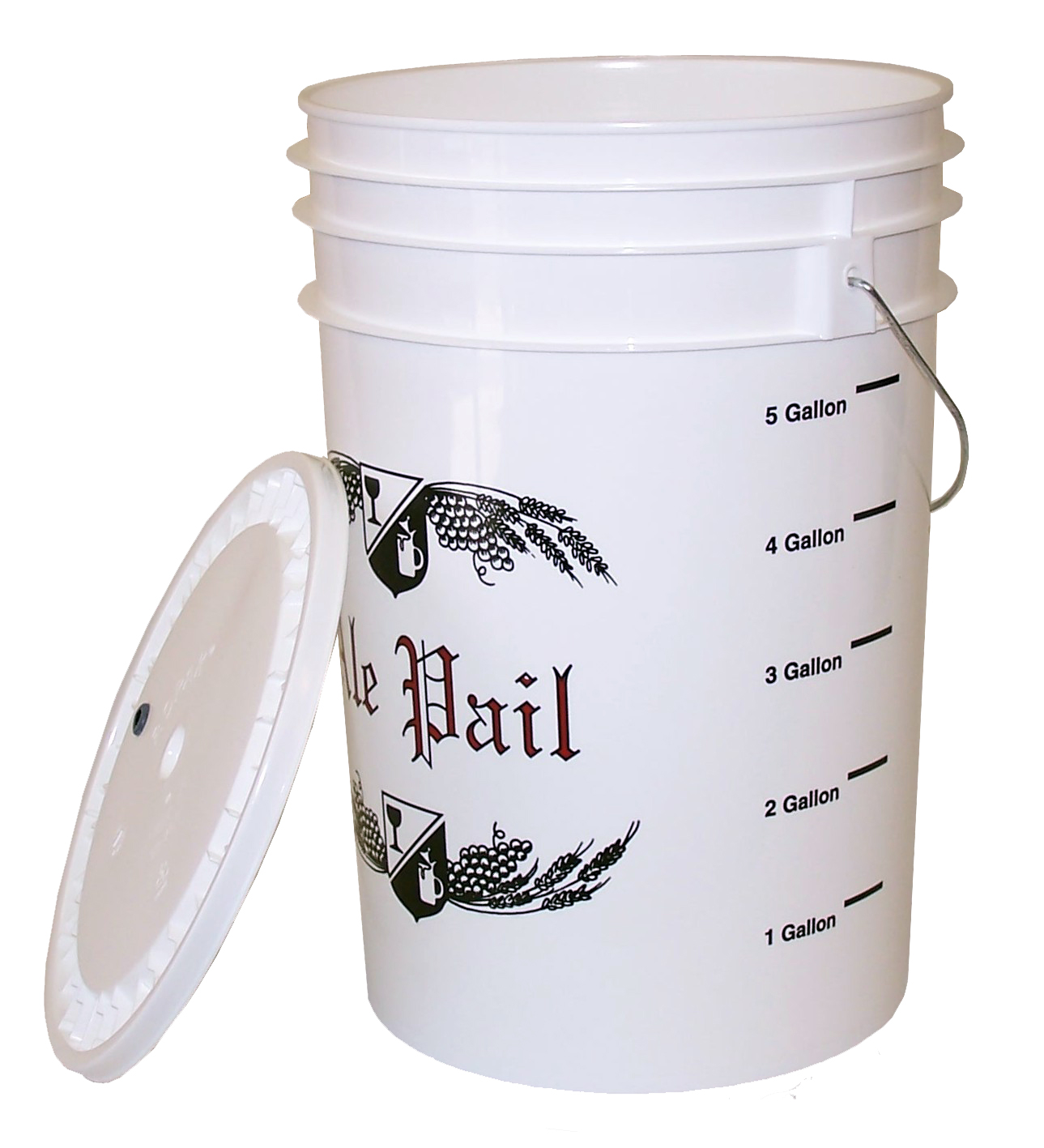 I never really questioned the 5-gallon standard prevalent among homebrewers. That’s the size of the first kit I bought, and beyond doubling to 10 gallons every once in a while, I never tried out different batch sizes. The 5-gallon standard is a standard for a reason. The volume fits in readily available 6.5 gallon food-grade buckets and in 5-gallon glass or plastic carboys. It also makes 2 cases of beer or completely fills a corny keg.
I never really questioned the 5-gallon standard prevalent among homebrewers. That’s the size of the first kit I bought, and beyond doubling to 10 gallons every once in a while, I never tried out different batch sizes. The 5-gallon standard is a standard for a reason. The volume fits in readily available 6.5 gallon food-grade buckets and in 5-gallon glass or plastic carboys. It also makes 2 cases of beer or completely fills a corny keg.
I’ve heard a lot about people brewing almost exclusively small, 1-gallon batches. I’ve been intrigued for some time as to the allure of small batch brewing. So when I received a gift for a 1-gallon brew kit from Brooklyn Brew Shop, I was excited to try it out.
Brooklyn Brew Shop’s Small Batch Kit
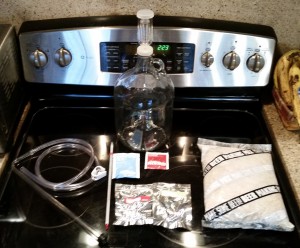 The kit came with a 1 gallon glass fermenter, airlock, tubing, thermometer, tubing clamp, and sanitizer. I was surprised that the kit was an all-grain recipe wother 2.5 lb of crushed grain. I assumed most beginner’s kits are extract kits. But I guess their rational is the batch size is small enough to mash in a stock pot.
The kit came with a 1 gallon glass fermenter, airlock, tubing, thermometer, tubing clamp, and sanitizer. I was surprised that the kit was an all-grain recipe wother 2.5 lb of crushed grain. I assumed most beginner’s kits are extract kits. But I guess their rational is the batch size is small enough to mash in a stock pot.
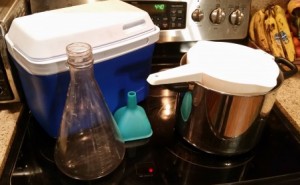 Beyond what came with the kit, I needed a few extra items. I decided to forgo the stock pot and used a small cooler as my mash tun. I used an Erlenmeyer flask to measure the water, a strainer for straining the wort from the grain, and a stock pot to boil the wort. I also grabbed a funnel for transferring wort into the fermentor. Besides the flask, all these items are laying around most kitchens, and should make it easy for anyone to just whip up a small batch of beer with no need to invest in brewing equipment. So far, this small batch brewing seemed like a great idea.
Beyond what came with the kit, I needed a few extra items. I decided to forgo the stock pot and used a small cooler as my mash tun. I used an Erlenmeyer flask to measure the water, a strainer for straining the wort from the grain, and a stock pot to boil the wort. I also grabbed a funnel for transferring wort into the fermentor. Besides the flask, all these items are laying around most kitchens, and should make it easy for anyone to just whip up a small batch of beer with no need to invest in brewing equipment. So far, this small batch brewing seemed like a great idea.
Brew Day
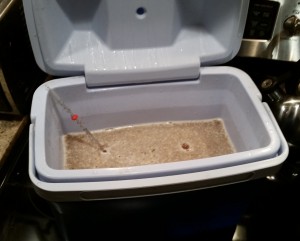 I mashed for an hour per the instructions, and strained the wort into the pot. Apparently the cooler was not designed to pour liquid, and I created a mess by having wort stream down the side of it. Not pleased that I lost some of my first runnings – strike one. Especially since the total volume I collected was just over a half gallon. At this scale, every ounce counts. After cleaning up my mess I returned the grain to the cooler and batch sparked with another half gallon of water. Again, transferring and straining the wort proved messy. Nonetheless I got (almost) everything transfered.
I mashed for an hour per the instructions, and strained the wort into the pot. Apparently the cooler was not designed to pour liquid, and I created a mess by having wort stream down the side of it. Not pleased that I lost some of my first runnings – strike one. Especially since the total volume I collected was just over a half gallon. At this scale, every ounce counts. After cleaning up my mess I returned the grain to the cooler and batch sparked with another half gallon of water. Again, transferring and straining the wort proved messy. Nonetheless I got (almost) everything transfered.
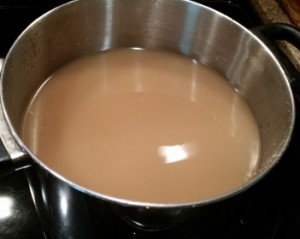 At this small scale and without the use of a false bottom, there really is no way to vorlauf. So the wort you collect is a cloudy mess. I tried to strain the wort back through the grain bed in the strainer, (per the instructions), but that did not clear up the wort – strike two.
At this small scale and without the use of a false bottom, there really is no way to vorlauf. So the wort you collect is a cloudy mess. I tried to strain the wort back through the grain bed in the strainer, (per the instructions), but that did not clear up the wort – strike two.
Nonethless, I proceeded with the boil, added the 4 (yes 4) Columbus pellets, followed by the finishing hops. After chilling the wort, I transfered it to the 1-gallon jug.
Fermentation
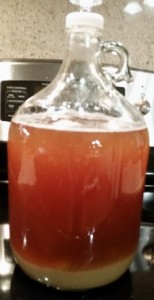 The instructions say to fill to 1 gallon, but I left a little bit of headspace as I expected the yeast to foam. However, even reducing the headspace some did not protect me from an overflowing mess – strike three.
The instructions say to fill to 1 gallon, but I left a little bit of headspace as I expected the yeast to foam. However, even reducing the headspace some did not protect me from an overflowing mess – strike three.
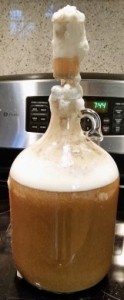 After a couple days the foaming subsided and only lost a little beer.
After a couple days the foaming subsided and only lost a little beer.
When it was time to bottle after a couple weeks, I got to thinking if I really wanted to go through the hassle of bottling. I had about 110 to 120 oz of beer/yeast cake. I figured I would recover about 90% of the beer, thereby leaving me with 100 oz or about 8.5 bottles. Was it worth the hassle of sanitizing 9 bottles and caps; dissolving, boiling, and cooling the 0.5 oz priming sugar; then filling the bottles that inevitably results in a sticky floor? No, not for 8.5 bottles of beer. I opted instead to transfer the beer into 2 2-L bottles and for carbonate from my kegging system. Much simpler.
Final Thoughts
Overall I’m glad I tried small-batch brewing. At least now I know what I’m not missing out on. The amount of effort to brew 8.5 bottles of beer was not much less than to brew two to four cases of beer. I can see this being an alternative way to make beer if you’re in an apartment, space is tight, and you’re stuck brewing on an electric stove. But even then, it’s a lot of work to make a beer that you and a buddy could go through in a single evening. Personally, I’m sticking with the 5-gallon standard.
Sorry, the comment form is closed at this time.